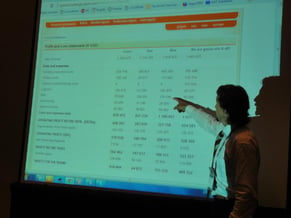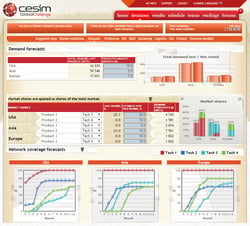 Hello educators, the new academic year is fast approaching. Are you thinking about incorporating business simulation games into your courses or training? Whether you are a new or experienced simulation user, we understand that you must be looking for the best strategies to ensure the smooth integration of the simulation and hopefully to achieve the maximum teaching and learning benefits. We want to help and contribute to the improvement of education quality and effectiveness, so we are reviewing some of the effective business simulator games teaching strategies in this month's blog post.
Hello educators, the new academic year is fast approaching. Are you thinking about incorporating business simulation games into your courses or training? Whether you are a new or experienced simulation user, we understand that you must be looking for the best strategies to ensure the smooth integration of the simulation and hopefully to achieve the maximum teaching and learning benefits. We want to help and contribute to the improvement of education quality and effectiveness, so we are reviewing some of the effective business simulator games teaching strategies in this month's blog post.
This blog post is a review of the effective business games teaching strategies discussed in "Effective Use of Business Simulation Games in International Business Courses". The article is written by Cesim Global Challenge (international business management game) adopter Tim Rogmans, Assistant Professor at College of Business at Zayed University, and published in the latest Academy of International Business Insights Volume 16 Issue 2 (2016).
Strategy 1 - Align simulation with learning objectives
 Since there are many decision making elements in a simulation game, for example in Global Challenge the business management simulation, there are demand, production, HR, R&D, marketing, logistics, transfer pricing and taxation, and finance decisions, instructors should decide "which decisions to emphasize, downplay, or ignore, in line with the planned learning goals of the course."
Since there are many decision making elements in a simulation game, for example in Global Challenge the business management simulation, there are demand, production, HR, R&D, marketing, logistics, transfer pricing and taxation, and finance decisions, instructors should decide "which decisions to emphasize, downplay, or ignore, in line with the planned learning goals of the course."
Let's take a look at how Aston Business School aligns Cesim Global Challenge to the school's learning objectives. Aston designed the Business Game Module with the purpose of ensuring students' concentration on key topic areas in classroom that they may overlook as a result of coming from different disciplines. Having established this learning goal, Aston instructors implement various scenarios and challenges into the Cesim simulation, so students get to learn the importance of social responsibility, ethics, and human resources. Just like Aston Business School, the majority of Cesim users find the scope of the simulations to be just right, as they align Cesim simulations with their school or course learning objectives.
| Brief-play-debrief activities (Rogmans, 2016) |
|
| Brief | Instructor explains rules of business game and required theories |
| Play | Students analyze information given and make decisions |
| Debrief | Students analyze results in classroom setting and link game playing process and results back to course learning objectives and real world of international business |
It is very important for instructors to first identify the learning objectives and use simulations as a tool or means to achieve the objectives. Rogmans suggests that the alignment can be ensured with a standard sequence of brief-play-debrief activities with a debrief session held after every business strategy game round.
Strategy 2 - Introduce complexity step by step
 As simulator games can be rather rich and complex for students, especially for those who are in undergraduate programs and do not have much hands-on business experience, instructors can delay the use of certain functions in the business strategy game to fit the course, so each simulation round has its own specific learning objectives.
As simulator games can be rather rich and complex for students, especially for those who are in undergraduate programs and do not have much hands-on business experience, instructors can delay the use of certain functions in the business strategy game to fit the course, so each simulation round has its own specific learning objectives.
|
Module options in Global Challenge |
| Human resources |
| Finished goods inventories |
| Corporate social responsibility |
| Transfer pricing |
| Equity financing |
| International treasury management |
| Company valuation |
Cesim business simulations offer customization and modules options for instructors to tailor the decisions to emphasize, the level and complexity of the simulation. There are several modules that can be enabled or disabled in Global Challenge, empowering instructors to curate the best business simulation experience for their students. Find out more about the customization options available in Global Challenge under "Modules" here.
More importantly, we usually advise instructors to go through 2-3 practice rounds with students, so they can get familiar with the decision making and the simulated business environment and perhaps get a good observation and formulate a winning strategy already.
Strategy 3 - Get to know the game before class
For academic leaders who are new to intuitive simulations, the best resources you can turn to for a better understanding of the business game are the materials made available by the simulation providers.
Let's hear what tips two of our Cesim experts have to share:
 "Try and get a student in access, see what it is like from the students' opinion, have some time to actually play with the game yourself to get that experience as a student, to see what decisions they would make. Then when you are an instructor, you have all these questions coming, you are more familiar with it." - Manisha Kumari, Curriculum Developer, Aston University
"Try and get a student in access, see what it is like from the students' opinion, have some time to actually play with the game yourself to get that experience as a student, to see what decisions they would make. Then when you are an instructor, you have all these questions coming, you are more familiar with it." - Manisha Kumari, Curriculum Developer, Aston University
 "Try to get some kind of consultations from instructors who are more experienced. That's what I'd like to have when I first started instructing business simulations, but I had no one to ask but the people at Cesim." - Eija Lipasti, Senior Lecturer, Laurea University of Applied Sciences
"Try to get some kind of consultations from instructors who are more experienced. That's what I'd like to have when I first started instructing business simulations, but I had no one to ask but the people at Cesim." - Eija Lipasti, Senior Lecturer, Laurea University of Applied Sciences
At Cesim, not only do we have a collection of guide books, webinars, videos and manuals to help you get started, our staff are here to answer your questions and walk you through the simulation in a language of your choosing upon request. Up to 90% of our users find our support materials highly useful for them to understand Cesim business games and our support team helpful in solving their problems.
Strategy 4 - Facilitate learning as the guide
As you are adopting a new teaching tool in your course or training, you must be wondering, "What kind of role should I take during the simulation game, and how can I help my students get the most out of the simulation experience?" Rogmans suggests that instructors should be the "guide on the side", so as to "help students to think through what may be the consequences of certain decisions and link such analysis to the learning objectives of the course."
This guiding practice is shared among our fellow experienced Global Challenge adopters:
 "As a professor and a former practitioner, as my team of teachers, we are very involved in the game. We spend a lot of time to help them to understand how to analyze their situation and what are the best ways and tools to structure a sustainable competitive strategy. At the end of the week, they have learned a lot, on strategy, finance, HRM, and Supply Chain Management!" - Olivier Cateura, Professor in Strategic Management, Grenoble Ecole de Management
"As a professor and a former practitioner, as my team of teachers, we are very involved in the game. We spend a lot of time to help them to understand how to analyze their situation and what are the best ways and tools to structure a sustainable competitive strategy. At the end of the week, they have learned a lot, on strategy, finance, HRM, and Supply Chain Management!" - Olivier Cateura, Professor in Strategic Management, Grenoble Ecole de Management
 "We try to advise students even more than telling them what to do. We have to be very keen on the game to provide them keys for explaining the competition, the trend, some figures and show where to find and analyze information. We suggest different tools, ways of screening, connecting with the strategy. We also suggest that they try and make errors to improve!" - Sylvie Humbert, Grenoble Institute of Technology (INP Grenoble)
"We try to advise students even more than telling them what to do. We have to be very keen on the game to provide them keys for explaining the competition, the trend, some figures and show where to find and analyze information. We suggest different tools, ways of screening, connecting with the strategy. We also suggest that they try and make errors to improve!" - Sylvie Humbert, Grenoble Institute of Technology (INP Grenoble)
Strategy 5 - Include simulation in assessment
Rogmans believes the most stratightforward way to keep students engaged and motivated in the game is to award points according to the team ranking in the simulation, or instructors can decide on a set of winning criteria and communicate to students about the measures. However, he points out that "game performance may not always be a good reflection of learning and understanding.", and other methods to include the simulation in student assessment are exams, essays, and group presentations.
 When granting points to students based on the game, we normally suggest instructors to give a grade not only according to the team ranking but also how the team play and strategize in the simulation. As an example of how to design an undergraduate course around the simulation, Aston Business School requires students to finish an individual 12-entry reflective portfolio and a log book, as well as a group consultancy report, a group log book, a group business plan and presentation. As for a MBA course, Coventry University's module assessment includes a team engagement plan before the first simulation round and a mid business review and a final portfolio of 12,500 words after the 4th round. Apart from the mentioned assessment, Cesim simulations also have the quiz function enabling educators to measure students' understanding of different business functions with customized questions.
When granting points to students based on the game, we normally suggest instructors to give a grade not only according to the team ranking but also how the team play and strategize in the simulation. As an example of how to design an undergraduate course around the simulation, Aston Business School requires students to finish an individual 12-entry reflective portfolio and a log book, as well as a group consultancy report, a group log book, a group business plan and presentation. As for a MBA course, Coventry University's module assessment includes a team engagement plan before the first simulation round and a mid business review and a final portfolio of 12,500 words after the 4th round. Apart from the mentioned assessment, Cesim simulations also have the quiz function enabling educators to measure students' understanding of different business functions with customized questions.
Strategy 6 - Open up the model
The last strategy suggested by Rogmans should take place after the game play for instructors to "discuss the assumptions and parameters of the underlying model" of the simulation game with students, to reflect on the behavior of the game that even though the model simplifies reality, it allows learners to focus on a specific set of variables and possibly relate the lessons learned in the simulated environment to those in the real world.
In Cesim simulations, every round has a different outlook which is based on the parameters that are defined for the simulation for each round. The parameters of the game form a base for calculating results on a marketplace. A default set of parameters are already defined for the basic case and those are automatically available when creating a course. Apart from the default setting, it is also possible to change these parameters, rewrite market outlooks and story line, and thereby create your own individualized case for your course or training.
We hope our review provides insights to improve your simulation teaching strategies. Interested in finding out more about how to use simulations in your course or training? We have a collection of case studies on our blog >>


